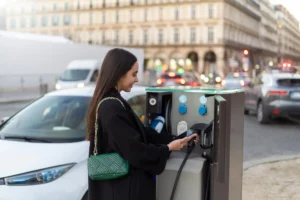
Home / EV Charging News / Electric Cars and Green Building Regulations
In the dynamic landscape of urban development, the rise of electric vehicles (EVs) is leaving an indelible mark on how we conceive and construct buildings. This article explores the intricate relationship between electric cars and the evolution of green building regulations, shedding light on how these codes are adapting to seamlessly incorporate provisions for electric vehicle charging infrastructure in new constructions.
As electric cars increasingly become a fixture on our roads, the need for accessible and convenient charging options becomes more pronounced. This section underscores the pivotal role of electric vehicle charging infrastructure, emphasizing its significance in promoting sustainable transportation. The discussion extends to the imperative of integrating these provisions into the initial planning stages of construction projects, laying the foundation for a more sustainable and future-ready urban infrastructure.
While green building regulations have traditionally prioritized aspects such as energy efficiency, water conservation, and the use of sustainable materials, the evolution of these codes is now embracing a new dimension. The incorporation of provisions for electric vehicle charging infrastructure represents a paradigm shift in sustainable construction. This section offers an overview of the ongoing revolution in green building regulations, highlighting the expanded focus on creating infrastructure that aligns with the demands of our increasingly electrified transportation landscape.
Transitioning from conceptualizing green building codes to implementing them in concrete constructions comes with its set of challenges. This section explores the practical hurdles faced in integrating electric vehicle charging infrastructure into new constructions. It delves into considerations such as retrofitting existing structures, the costs associated with implementation, and the collaborative efforts required from various stakeholders, including architects, builders, and city planners.
Governments play a crucial role in incentivizing sustainable development, and this includes encouraging the integration of electric vehicle charging infrastructure in new constructions. This section examines the policy measures taken by governments to promote the seamless amalgamation of green building codes and electric mobility. It showcases examples of jurisdictions where incentives and regulations work in tandem to foster a more sustainable and EV-friendly built environment.
Beyond compliance with regulations, architects are leveraging their creativity to design spaces that seamlessly incorporate electric vehicle charging infrastructure. This section explores innovative architectural solutions that go beyond mere compliance, creating environments where EV charging stations are seamlessly integrated, aesthetically pleasing, and contribute to the overall functionality of the space.
As green building regulations continue to evolve, collaboration emerges as a cornerstone for success. This section explores the importance of collaborative solutions involving architects, urban planners, policymakers, and the community. The engagement of local communities in the planning and execution of sustainable projects ensures that the integration of electric vehicle charging infrastructure aligns with the unique needs and dynamics of each neighborhood.
Technological advancements are playing a pivotal role in shaping sustainable urban spaces that seamlessly integrate electric vehicle charging infrastructure. This section delves into the latest innovations, such as smart charging solutions, integrated energy management systems, and digital platforms that enhance the efficiency and accessibility of electric vehicle charging within green buildings. The synergy between technology and sustainable urban development becomes a driving force for a future where cities are not just eco-friendly but technologically adept.
Drawing inspiration from global best practices, this section highlights examples of sustainable cities that have successfully integrated electric vehicle charging provisions into their green building frameworks. Case studies from cities around the world illustrate diverse approaches and innovative solutions, offering valuable insights for urban planners and policymakers seeking to replicate these successes in their own communities.
In the journey towards sustainable urban development, community education and awareness play a crucial role. This section explores initiatives aimed at fostering a green mindset within communities, emphasizing the benefits of electric vehicle charging infrastructure in contributing to a cleaner and more sustainable urban environment. By engaging and educating residents, these initiatives create a sense of shared responsibility for building a future where green buildings and electric mobility coexist harmoniously.
To further drive the adoption of electric vehicle charging infrastructure in new constructions, this section examines the role of economic incentives for developers. Governments and municipalities are increasingly providing financial incentives to developers who incorporate sustainable practices, including EV charging provisions, into their projects. The discussion explores the positive impact of these incentives in encouraging developers to embrace green building regulations and contribute to the broader goals of urban sustainability.
As the article concludes, the narrative comes full circle, emphasizing the pivotal role of electric cars in reshaping the urban landscape through the evolution of green building regulations. The envisioned future is one where sustainable urban living is not just a concept but a tangible reality. The integration of electric vehicle charging infrastructure into green buildings becomes a catalyst for a holistic transformation—a blueprint for cities that are environmentally conscious, technologically advanced, and community-driven. In this future, every construction project is not just a building; it’s a testament to the harmonious coexistence of sustainable architecture and the electrified mobility that propels us towards a cleaner, greener, and more connected urban future.
